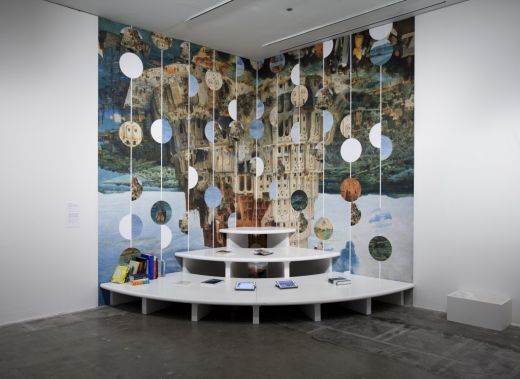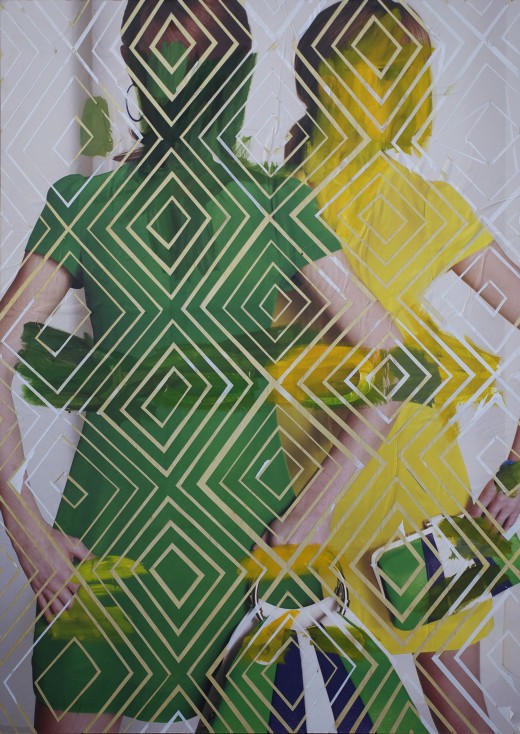- Do You Really Want to See Eight Motorcycles in the Globe of Steel?

- “Avocado Mountain” and The Ostrich Hunt
New Work Miami 2013
Helen L. Kohen

New Work Miami 2013. Installation view Miami Art Museum. Courtesy Miami Art Museum. Photo by Oriol Tarridas.
Miami Art Museum
November 21, 2012 – June 2, 2013
The exhibition is a group effort of a new sort, not just because there are 11 Miami artists involved in the show, but because two of them—Consuelo Castañeda and Emmett Moore—designed the presentation, heavily influencing its look and its ironic spirit. In addition, the Miami collective the end/SPRING BREAK (Domingo Castillo, Patti Hernandez, and Kathryn Marks) has devised the public programming for New Work. Museum curators René Morales and Diana Nawi, who chose the participating artists, top off the orchestration of this winning production, and a true production it is, with all the theatrical overtones that implies.
The artworks are arranged within and without the architectural surround Castañeda and Moore provide, each piece selectively placed near, inside, or on what Nawi describes as examples of the “overly imagined” symbols of this tropical town. There are two faux marble painted walls in the lobby, a wall of glass brick as you enter the galleries, a pierced concrete decorative divider between galleries, a striped awning over a sunless opening, a too-high hedge of plastic greenery, a series of badly-scaled architectural arcades, and two pastel walls—a flat one decked out in sea foam green and one deco’d–up in sky blue. Which is not to forget the ubiquitous street pavers that elsewhere serve as an extended pedestal, the same pavers as those currently appearing at corners and crossroads in your neighborhood.

Loriel Beltran, Primitive Girls, 2012, Oil on found poster on wood panel, 42 x 60 inches. Photo courtesy of the artist and Frederic Snitzer Gallery.
Not that there is nothing to make you squirm. Gideon Barnett’s inkjet prints of Miami sites and citizens are as shiny, seductive, and as patiently scrutinized as a Northern Renaissance painting—Hieronymus Bosch comes to mind—and like a Bosch, almost more detailed than you care to see. To create these seemingly observed images the artist takes a series of photographs that are then digitally stitched into tableaux. His image of a homeless man asleep on a low stone wall is equally enticing and disturbing, the work of a master voyeur. And I confess some discomfort with Sinisa Kukec’s “That which makes you stronger …will most likely kill us” (2012), an ominous title that is preparation for an edgy sculpture. It’s an upholstered pair of tilting high-backed chairs tottering on the aforementioned pavers, here partially covered with a thick, gross and glittery black epoxy anchoring the sculpture. For a more neutral if still telling take on Miami, there is Bhakti Baxter’s overarching work, a gallery-long and a gallery-high wall installation of paintings on earth-toned sheets of paper. Pictured are many of the most familiar canonic artifacts of lost and plundered civilizations, randomly placed between and among blank sheets. The anthropomorphic specimens, from pre-Columbian effigy vessels to a Sepik River mask, underline the presence in this showcase of items from the material culture of our place and time.
Some of the artworks have no Miami reference. Moira Holohan’s 3-channel video, an arresting black and white work of intersecting phantom images and quickly moving abstractions could have come from anywhere, and might have been made anytime. Her vision is timeless, as is that of Odalis Valdivieso. The process here is everything, the purposeful manipulation of photography, printing, scanning, painting, and folding. At the end, the original image or theme or meaning is long lost, giving way to the small and handsome retro-looking abstractions we see. We are back to 2013 and the 305 with the works of Loriel Beltran, whose series of five related pieces, all of them oil paintings on found posters on panels, occupy the diminished spaces of the arcades. It’s a lively group, especially those with remnants of their original luxe images, now defaced with splashes of color. The “them-and-us” mind-set continues in Beltran’s two sculptural works, both of which remark on the use of granite as a key status symbol in the bathrooms and kitchens of Miami’s pricier homes. Looking like funeral steles, the structures are built tall of differing sections and types of the stone obviously pre-cut for other uses. They become shaky monuments to South Florida’s building excesses, and subsequent foreclosures.
But surely the most Miami-like happening in the show has evolved as a result of Tom Scicluna’s “Public Sculpture” (2012), a work that features two actual Metro-owned bicycle racks, borrowed with all the correct procedures and paperwork from county officials. They were placed inside the MAM lobby for the length of the show. The idea was to have the riders rack their bikes in the museum rather than outside on the plaza, thus bringing in some bike riders who never before entered the museum. To their benefit, it was also a chance to have their bikes actually secured, for the outside racks were usually overstocked, and under-policed. But then more racks appeared on the plaza, so the artwork lost part of its impact and most of its mass.
It’s not the first time the museum and the county went their individual ways. MAM started out in 1984 as the Center for the Fine Arts, a county-owned kunsthalle not much interested in local artists. When the institution became a private, collecting entity (the county still owns the building) and took the city’s name as the Miami Art Museum in the mid-90s, that attitude changed. MAM inaugurated a New Work gallery space to showcase projects of one or two artists, and many of those installations were by such locals as Barbara Neijna, José Bedia, Robert Chambers, and Glexis Novoa. After the gallery disappeared following a renovation of the museum, the New Work designation stuck. It signals that attention is being paid to our own, at least to those artists living/working in town. This New Work iteration has only two artists born here. Still, it appears that it doesn’t take long to catch the crazy spirit of Miami, to mimic it, to celebrate it, to satirize it and, or, to ignore it.









